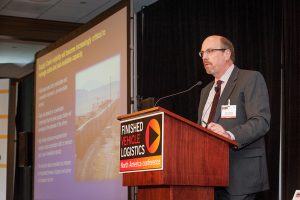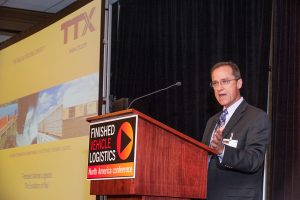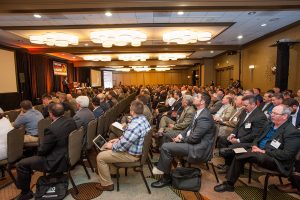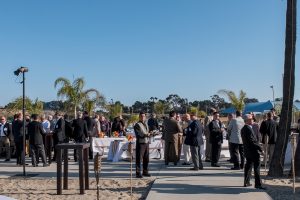The 6th annual FVL North America conference brought together 350 delegates to sunny California, where they discussed the lingering chill of winter affecting the logistics network, at the same time that sales and investment in the sector continue to sizzle
Additional reporting by Marcus Williams and Rachael Hogg
It was the best of times, it was the worst of times… it was the spring of hope, it was the winter of despair, we had everything before us, we had nothing before us, we were all going direct to heaven, we were all going direct the other way. – Charles Dickens, ‘A Tales of Two Cities’
Dickens’s descriptions of London and Paris on the cusp of the French revolution might seem a long way in time and space from the North American vehicle logistics industry, especially a conference set besides the palm trees and yachts moored in the marina of Newport Beach, California. However, speakers and delegates from carmakers and logistics providers echoed a duality of sentiments at the conference, where continued operational, regulatory and capacity issues tempered a positive outlook.
Many executives were overtly optimistic over growth in the automotive industry, which has brought with it investment in logistics services, equipment and new facilities. Technology and IT providers also continue to innovate, seeking to use smartphone and mobile technology to provide better visibility and connect carmakers and logistics providers more closely than ever before. The drop in fuel prices, which are some 50% lower than they were a year ago, has also boosted economic growth and cut logistics costs.
See stories below for more reports from the 2015 FVL North America Conference:
However, executives were also honest about their worries over delivery lead times and continued disruptions across the rail network and at automotive yards. A growing driver shortage, and restriction on various truck operations have further hurt road providers. Meanwhile, a lack of investment in wider US infrastructure in ports and highways, together with delays to the government’s bill to fund and regulate such critical areas, were also seen as a risk.
Ultimately, there were a number of executives who feared such issues would lead from the best to the worst of times, by hurting sales and profits both for carmakers and logistics providers. Others perhaps had more reason to cheer, even amidst tough conditions. Gerald Lee, vice-president of vehicle planning and logistics at Subaru of America, used the Dickens quote in another sense altogether, describing the carmaker’s remarkable growth in recent years despite very low vehicle inventory, a scenario that has forced Subaru to improve forward planning in its orders and pipeline. That’s a duality most in the industry would like to emulate.
It was the best of times…
The US vehicle market continues to experience a renaissance. Sales in the US this past May reached their highest selling rate in more than a decade – at around 17.8m on a seasonally adjusted annual rate – and are currently up around 5% in the year-to-date compared to 2014. Brandon Mason, senior analyst and Americas leader at PwC Autofacts, predicted sales would go back over the 17m mark this year following 16.5m last year. Production, meanwhile, continues to rise both in the US and Mexico. PwC currently expects that total light vehicle assembly across North America will grow from more than 17m units to 2014 to about 20m by 2021, with the most assembly growth coming from Mexico.

David Sellers, assistant vice-president of automotive for railway rack and railcar (wagon) pool management firm, TTX, pointed to significant investment in equipment, including order forecasts of more than 3,600 railcars in both 2015 and 2016. “These are really exciting times. I don’t think people stand back and appreciate how good the auto industry is right now,” he said. “It was the first industry out of recession, and growth has been sustained. People get enamoured by other sectors like shale gas and crude, some of which are starting to fade.”
“It’s a good time to be in our business, that’s what everyone keeps saying,” said Gary Salvador, senior vice-president of sales and marketing at terminal operator Amports. He pointed to growing exports out of Mexico, for example, that were leading to the creation of new short-sea routes and shipping terminals at alternative ports, including on the Gulf coast in Texas and in Florida.
Executives at carmakers were also generally upbeat about the industry and their logistics providers. “Everyone here is in agreement that the industry is strong, the volume is good, and we will continue to grow,” said Glenn Clift, president of Glovis America, which manages logistics for Hyundai and Kia. “Railroads have put in a lot about the investment they’re making, and the truckers I’ve talked to are doing the same.”
Brian Mason, national manager for strategy and communication at Toyota Logistics Services (TLS), complimented trucking providers, railways and processing operators on improving their communication across the network. “We’ve gotten over the angry stage and wanting to fight,” said Mason. “Now we’re ready to work together.” (Read more here.)
Jan Bures, executive vice-president of aftersales and service from Volkswagen Group of America, also extended a thank you to both truck and rail providers in helping to keep the carmaker’s vehicles moving during difficult times. “Thank you for digging us out this past winter,” he said, leading a round of applause. “Without our ports, our carriers and providers, we wouldn’t be able to maintain our network.”
It was the worst of times…
For all the positivity, however, there were signs that not all was quite well in paradise. The ‘winter of despair’ may not be evident in California, but few can forget or ignore the icy chill that has been felt across the network the past two winters. While it is generally agreed that 2015 was not as bad as last year, the industry still dealt with slowdowns from snow and cold weather, as well as the west coast port disputes, which contributed to delays in rail service and cycle time (the time it takes to reposition empty railcars back to points of consumption).

Trucking providers are also having issues. Jack Cooper’s Sarah Amico said that the environment for operating trucks had changed drastically, with huge variability and inconsistency of vehicle releases. She provided data from one terminal that showed daily variations in volume of up to 25%. “We have built a network around variability of perhaps 10-15%, but now experience levels that look like an EKG chart,” she said, indicating the steep lines moving up and down across a monthly chart of vehicle releases.
Amico’s father, Mike Riggs, the chief executive offer and owner of Jack Cooper Holdings, also pointed out that some in the industry seem to moving directly the opposite way from heaven, thanks to a combination of driver shortages, regulatory restrictions on fuel emissions, loading weight, overhang, driver hours and other issues that reduce load factors. “We’re dying,” he said, reeling off a list of carriers that went into bankruptcy or liquidation over the past 6-7 years, including Ryder, Swift Transportation, PTS, Accurate and Allied (which Jack Cooper later acquired).
Riggs is currently leading lobby efforts to gain weight exemptions and increase overhang for the car hauler sector, but the outcome is far from certain and could face resistance from the railway lobby. (Read more here.)
Shipping lines and port operators, too, are not necessarily heading straight to heaven. The shift in production to Mexico or the US from Japan, South Korea and Europe has, in some cases, disrupted import flows and shipping routes. Ro-ro lines are experiencing low freight rates. While there is generally growth of vehicle volumes at ports, some locations remain well off their peak volume. Even with optimistic forecasts, for example, the port of New York and Jersey does not anticipate total motor vehicle trade (including used vehicles) to surpass its 2008 peak of more than 1m vehicles until 2021, according to Gary Love, vice-president of sales and marketing at port processor FAPS.

Some executives felt the logistics crunch was having a material impact on the market, certainly in customer satisfaction if not directly on sales. Volkswagen’s Bures said that the carmaker had recently been told by National Automobile Dealers Association that it needed to improve delivery, a warning he was taking very seriously. (Read more here.)
“We need an efficient and functioning logistics network to keep our growth plans alive,” he said. “We are currently not performing at a level where we think we should be. Our dealers are not receiving the service we have promised them.”
Matt McCoy, operations manager at General Motors, who also pointed to improvements in forecasting and communications this year among railroads and trucking providers, nevertheless agreed that the performance indicators in 2015 were at about the same level as 2014, including in empty supply, with high ground inventory as a result.
“What we’re seeing today is not what we expected it to be. We continue to delay vehicles to our customers,” he said.
Capitol Hill bottlenecks
At a wider infrastructure level, the US is facing other problems that could risk both logistical effectiveness and growth, particularly a lack of investment in its major interstate highways, bridges and port gateways. Mario Cordero, chairman of the US Federal Maritime Commission, a government body regulating shipping carrier and port agreements, pointed to a reoccurring problem of congestion at US ports that was already having negative impacts on growth and trade.
“This is not limited to the west coast and labour issues,” said Cordero. “There are issues related to land connections and chassis shortages across the country, and this is also impacting the ro-ro sector.”

There has also been chronic underinvestment in the US highway network, according to experts. Jason Kuehn, vice-president of the transportation practice at consultancy Oliver Wyman, pointed to research showing that the country needed at least $35 billion per year in infrastructure investment just to sustain its current highway levels – and yet it was only spending around $25 billion. The backlog for bridge and highway projects is more than $90 billion, while state and municipal roads are equally underfunded.
The Obama administration unveiled a $478 billion transportation bill this past March that would treble investment levels in highways, as well as increase funding for many infrastructure and port projects across the country. Its passage has already been delayed, however, following a pattern of more than 30 temporary highway-funding measures over the past six years as Congress fails to act on a more long-term law.
Within this bill are also many other potential items that could be important to the vehicle logistics industry. Just a few examples include potential increases in weight allowance and overhang length for car carriers that Mike Riggs is advocating for. Likewise, Bill Pawluk, chief executive officer of Convertible Trailer Manufacturing, also hopes to resolve a legislative issue that currently prevents his specialised equipment, which converts from carrying vehicles to general freight, from using its full capacity when carrying general freight.
Cordero called for more investment directed at ports and the country’s road network, encouraging the automotive logistics industry to push the government further. “The automotive industry should continue to advocate for infrastructure. I can’t stress how important for all stakeholders, importers, and exporters, to hit home that we need to address this. It has been far too delayed, and for too long,” he said.
He cited one economist who even pointed out that the greatest threat to international trade in the US is not terrorism, but a lack of infrastructure. “Keep demanding investment in it,” he said.
Give your railroad some love
The worrying lack of investment in roads, however, put into sharp relief the amount of capital investment that is being poured into the railways. Oliver Wyman’s Keuhn pointed out that, despite the service issues that carmakers and other shippers have experienced, “You’re getting a better deal than you think.”

“I know it is hard to do after last year but embrace your railroad, they will be the solution to problems in the future,” he told delegates.
Keuhn predicted that North American railways were in the midst of a “second renaissance”, whereby investment and operations become much more nimble, customer-focused and integrated into the economy’s growth areas.
The conference provided evidence that such investment in automotive growth was underway. Railways are buying more equipment for the shared pool of railcars, especially for bi-level equipment, which is used to move larger vehicles such as SUVs and trucks (tri-level railcars are used to move smaller vehicles). According to David Sellers at TTX, around 3,200 units were ordered in 2014, with than 3,500 units forecasted in both 2015 and next year. While more than 70% of railcar orders in 2012-2013 were for tri-levels, between 2014-2016 that order pattern is expected to reverse entirely, with nearly 75% of orders being for bi-levels, reflecting the swing towards larger vehicles in the US since the decline in the price of fuel.
Individual railways continue to expand their fleets and networks. “We have expanded all of our automotive facilities to make sure we have capacity for customers,” confirmed Tara Sprinkle, director of automotive marketing for BNSF.
Along with facility upgrades and double tracking of key routes, the company plans to acquire 1,500 bi-level and 175 tri-level railcars this year to accommodate the rise in vehicle movements across North America. The shift towards bi-levels reflects the increasing growth for larger vehicles in the US, including SUVs and pickup trucks.

Like BNSF, Norfolk Southern is also investing in new equipment and infrastructure for automotive. Josh Massey, director of automotive distribution, said the company had purchased a further 350 bi-levels and 150 tri-levels. Since the beginning of 2013 Norfolk Southern has grown its multilevel fleet by 7.5%.
Jason Steele, assistant vice-president for automotive at Union Pacific, pointed to expansion projects for vehicle import handling and capacity out of Mexico. For example, UP is double tracking the ‘sunset route’ that moves from the border at El Paso, Texas and Nogales, Arizona, through to Phoenix and southern California, major markets for vehicle sales. It is also upgrading most of its automotive yards, and has started construction of a major facility in Hearne, Texas, where seven rail lines converge.
“At full capacity this site will handle up to 2,500 railcars per day, and will pull cars out of Mexico for switching,” said Steele.
Numbers don’t tell everything
Such investment has not necessarily trickled through to better service yet this year, as carmakers continue to report both frequent deviations off of rail and onto truck for some routes, as well as permanent shifts in other cases. Glenn Clift said that Glovis is now shipping cars out of Hyundai and Kia plants in Alabama and Georgia as far as 1,000 miles (1,600km) away to western Texas, while it is exploring switching some current rail routes onto road to destinations such as New York and northern Michigan.
Brian Mason at Toyota said there have also been some cases where TLS has switched off rail to road after determining, together with railroads, which routes they could not effectively serve. “We worked with carriers to establish long-term contracts to allow them to build up their fleet and service to run these routes,” he said.

While overall volume on the rails has not necessarily been at record levels, demand has surged at points of the network that were somewhat underdeveloped, further exasperating the issue of moving empty equipment back to plants or ports. A more stable flow of cargo would have significantly more advantage that would a large increase in railcars, he said.
TTX’s Sellers agreed, pointing to a huge variance in vehicle releases throughout the week and the month. He stressed the strategic allocation of those rail assets rather than simply relying on numbers. Just as adding more vehicles onto a highway can slow it down with congestion rather than increasing speed, Sellers said that adding more railcars to the network could have a similar effect if the deployment is mismanaged. Improving consistency and repositioning would be far more beneficial. For example, one day of improved cycle time would be the equivalent of an extra 2,000 railcars, he said.
[sam_ad id=6 codes='true']However, with vehicle production capacity expansion and the growth of assembly in Mexico, the management of equipment will become even more difficult.
“A lot of the smaller vehicle production is moving to Mexico,” said Sellers. “Along with that is the fact that very few loads go to Mexico. The idea that you can get efficiency by running loads down there and reloading them in a short area and running them back does not happen in Mexico. Instead you are long hauling empties further distances.”
Systematic progress
This variability and inconsistency is in many ways as apparent for the trucking sector as for rail. Jack Cooper’s Sarah Amico pointed out how various kinds of vehicle holds lead to idle equipment across the carrier’s network. She pointed out that as the provider carries the full cost of labour and equipment, such holds go straight to a carrier’s bottom line.
“We are in a new area of post-recall phenomenon, quality holds and inconsistent releases,” she says. “Let’s not kid ourselves, this is the new normal so we are going to have to develop different strategies to address it.”
The conference revealed that many companies are indeed developing such strategies in response to this variability and the empty return miles common in the sector. One common response has been to attempt to transition more loading operations and dealerships towards extended hour operations. Josh Massey at Norfolk Southern, for example, pointed out how seven day per week loading, unloading and dealership deliveries would help to decrease cycle time and reduce vehicle dwell at rail yards.

Gerald Lee, vice-president of planning and logistics at Subaru of America, said that the carmaker has also been carrying out a campaign to encourage dealers to open later, including giving them special recognition and incentives, including during the carmaker’s annual business conference. So far 59 dealers have signed up for extended hours. “We’re encouraging our dealers to think about truckers as extensions of their business,” he said.
Along with extended delivery hours, IT systems were presented as having major potential to close gaps and inefficiencies in the industry. At Jack Cooper, Amico suggested that the solution could come in improved technology that would help both to improve vehicle loading and routing, as well as efforts to pool network intelligence across providers to find empty backhauls.
Amico unveiled a new software programme, called ‘The Davinci Tool’, that uses a complex set of algorithms to determine the most efficient and profitable load and route combination for each truck. As the profitability of a run is determined not only by the number of cars on the truck, but also the proximity of deliveries for each vehicle, and the length of the empty return, The Davinci Tool has been designed to automate such decisions and integrate the availability of return loads, presenting drivers with a list of the top ten best options.
Amico also invited other carriers and OEMs to share more information about their loads and network in a pooled network system, managed using Llamasoft supply chain design software, that would help each company to avoid returning empty.
“Over the past year we did a targeted study with carriers to determine which large dealerships would give them the most bang for their buck in terms of extending their delivery hours” – Matt McCoy, General Motors
Jack Cooper was not the only carrier touting similar systems. Matt Cartwright, the chief information officer at United Road, the second largest US carrier, said that the company had also introduced new systems to improve routing, visibility and yard management. Technology provider Car Delivery Network (CDN), meanwhile, has also created mobile software that can pool together loads, as well as provide services such as electronic proof of delivery. Indeed, following their session together, Cartwright, together with CDN managing directory, Wayne Pollock, agreed to create a shared platform that will try to combine where industry flows on an open platform. CTM, meanwhile, has partnered with Germany’s Inform on a platform intended to help capture backhauls, including those outside the vehicle logistics sector, such as the inbound parts or general freight that CTM equipment can also carry.
The growing frequency of deviations and spot has also driven an increased need for ad hoc transport, a business area that technology firms are also looking to capture. Companies such as Montway Auto Transport and Metrogistics, two technology and carrier brokers that style themselves as the ‘Uber of vehicle logistics’, are seeing more new vehicle moves used on their platforms, or pushing into contract logistics.
Rail providers also pointed to system and process improvements. One of the major projects at Norfolk Southern has been the rewriting of its entire automotive terminal operating system with conglomerate firm GE. The system promises to reduce volume dwell at its terminals and increase multilevel productivity and velocity, according to Massey.
“This is a huge undertaking and will have a great effect on our automotive throughput at the terminals,” he said. “This product will make sure we are maximising our productivity and throughput at each and every one of our terminals everyday.”

Responding to change
The changes in the North American vehicle logistics industry are real, and complex. The growth out of Mexico is creating new geographies and pressure within the vehicle logistics network, including new ports and rail services. At Honda, for example, its new plant in Celaya, Mexico has not only created more volume to the US, but also more global exports beyond the NAFTA bloc, the logistics for which are now managed centrally since September last year by American Honda, the carmaker's US sales arm based in California.
Charles Franklin, manager of export logistics, reveals that taking over Mexican exports will increase annual volume by 26 destinations and 39,000 units, on top of the roughly 115,000 exports Honda ships from the US beyond NAFTA. Honda uses eight ports and processors in the US and Mexico, 14 ro-ro providers, seven trucking companies, six railways, two container lines and two freight forwarders. Franklin’s team now runs these bids, including the ocean shipping.

With these new dynamics, Gary Love from FAPS predicted that carmakers would start to look again at new port options in its network in the coming years, which in some cases could include a move back to large ports like New York and New Jersey. In other cases, this could lead to new options: Amport’s Gary Salvador pointed to Florida’s port of Tampa, which is just 2.5 sailing days from Veracruz.
Per Folkesson, president of the Americas for Höegh Autoliners, revealed that the shipping line would be opening a new terminal at Freeport, on the Gulf Coast in Texas, at a facility in which it will also partner with Amports.
“Especially with the Panama Canal project, we think it could be much more efficient to move vehicles destined for Texas and surrounding regions directly to the Gulf rather than to the west coast and then use rail,” Folkesson said.

“We’re more than 600 miles from Veracruz, and we don’t see port and short sea services developing to handle the increases,” he said. “We anticipate continuing to use mainly rail for exports from Mexico.”
Be consistent where you can be
Such changes, investments and decisions will vary by carmaker and logistics providers. All agreed that communication and collaboration would be increasingly important, with most committing to more dialogue across both carmakers and logistics providers. Most admitted, however, that it was difficult to work in advance, hard to improve forecasts, and in some cases, not possible to share or get more detailed information from within their companies.
One carmaker gave an example that stood somewhat in contrast. It was Gerald Lee who said that Subaru was experiencing a "best of Times, worst of times" scenario with its huge growth in recent years, combined with razor thin inventory levels. While this situation has presented its challenges, including a network of dealers clamouring for more product, frustrated further by rail delivery issues not helping, the lower inventory has also driven a great reliance on using retailers’ pipeline information to manage the supply chain.

This consistency could go a long way towards improving the kind of instability and inconsistency that characterises so much about what makes rail, trucking and shipping logistics difficult in the automotive industry. Subaru’s good track record relies on a mix of systems integration, advanced sales planning, educating dealers about ordering habits and the benefits of extended delivery hours, as well as shared information with carriers. That is not a simple checklist, however it may offer some hope for other manufacturers to consider before the spring of hope in California turns back to the winter of despair for the wider industry.
Video recordings of the main sessions at this year’s Finished Vehicle Logistics North America conference can be viewed by clicking here.
The next conference in the Automotive Logistics series of global events will be Automotive Logistics Russia in Moscow on June 23-24th.
The next conferences in the North American market will be Import/Export North America on August 12th in Baltimore, following by Automotive Logistics Global on September 22-24th in Detroit.

























